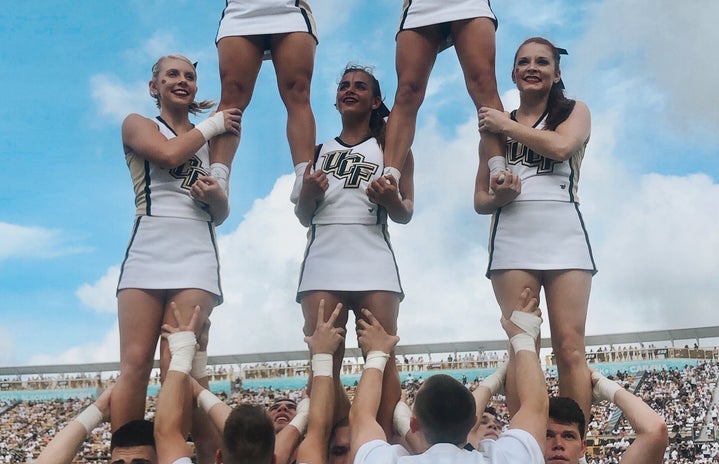Cheerleading is commonly seen as a sport dominated by women, so the fact that it started as an all-male pep club in the 1880’s may come as a surprise to people. It wasn’t until 1923 that women could cheer, and only in the 1940’s, when men had to leave the universities to fight in World War II, they started joining the teams in large numbers.
It was meant to be an easy dance with battle cries to lift the spirits of the team that would be playing in the field and the rest of the crowd. It was never meant to be a sport, especially when women took over. It started to become competitive in 1955, but without the acrobatics and the gymnastics that we know.
In 1972, the Dallas Cowboys owner decided that he wanted the cheerleaders to be more entertaining, especially for the male audience, because “he knew the public liked pretty girls”, so he hired choreographer Texie Waterman and director Suzanne Mitchell, and they transformed cheerleading in a sensual performance in short shorts and midriff-bearing uniforms. Cheerleaders were supposed to be alluring, yet pure. And so, the stigma was born. They were pretty, they were tempting, but untouchable. In a higher position, in a pedestal, and so have been the athletes represented in the media. A New York Times article from 1977 writes: “With their short shorts, crop top, vest and white boots, the Cowboy cheerleaders hardly resemble the spirited State U. coeds of the past in long skirts and bobby socks.”. In that same year, other pro cheerleading teams started to copy the Dallas Cowboys aesthetic, and the Washington Post declares, “Their disco dancing, skimpy costumes and sultry looks have become the prototype of the new cheerleader”.
Although the owner of the Dallas Cowboys wanted to keep the “catholic and pure” image of the cheerleaders, the media started to hypersexualize the girls and the sport, and it has been happening ever since. The kick-start was the movie Debbie Does Dallas, from 1979, in which the lead character, dressed in a uniform nearly identical to that of the Cowboys cheerleaders, exchanges sex for money in order to save up to travel to Dallas to try out for the “Texas Cowgirls.”. The Cowboys sued the company, but that did not stop numerous sequels from happening.
That did not stop other movies from coming out and perpetuating the stereotype. It seems like and old-fashioned view, since cheerleading has come a long way throughout history, but, in the last decades, there are multiple examples of how the sport has become, on the eyes of Hollywood, nothing but a sexy girly dance for high-schoolers.
For example, the movie But I’m a Cheerleader (1999), in which Megan (Natasha Lyonne) is a straight A student, a cheerleader in high school with a football-playing boyfriend and, overall, the typical all American girl until her parents start suspecting she might be a lesbian. This comedy from the late 90’s displays the cheerleaders as feminine rich girls at the top of the high school hierarchy. In fact, that’s the joke in the title: how can Natasha Lyonne’s character be a lesbian if she’s a cheerleader (inserting not only the sport stereotypes, but also the sexuality ones)? It’s also shown as a girls-only activity, which reinforced gender roles in the sport – that is not even considered a sport in the movie, only an easy dance with pom-poms and pretty girls spelling W-I-N in the sideline of actual sports.
From the year after that, 2000, we have the iconic first movie from the Bring It On series, that tells the story of the Toro cheerleading squad from Rancho Carne High School in San Diego that has to win the championship against the “mean girls”. Bring It On is the most famous movie when it comes to cheerleading, and it does show the sport for what it is, with the competitions and the acrobatics, but it is still showcased as a sexual dance for skinny blond popular girls. There’s even a scene where the coach calls the cheerleaders “dancers who have gone retarded”; an offensive line and a clear vision of how these athletes are portrayed in the media. The girls in the team are silly, dumb and friendly, as the rivals are sexy, mean and rule the school in a short skirt, a clash between the two most popular stereotypes about the sport. The fact that the uniform is shown as a huge part of what makes these girls so sexualized is one of the most harmful misconceptions that Bring It On and other movies from this same genre has brought to real life, leading to harassment being common in the sport, since the aerodynamical clothing is seeing as “revealing” and “sexy”.
For a more recent example: though the theme of Glee (2009-2015) is not really cheerleading, there’s no doubt that they play a huge part in the story. Their ambitious coach is the main antagonist, dragging her athletes with her into her crazy plans to defeat the glee club. Cheer is shown as a real sport, and the fictional team has been winning championships for a long time and it’s as acclaimed as the football team. But the girls are mean, practice bullying with the other students and can’t accept that a fat girl or a girl with down syndrome could be a part of the team (since both situations happen in the show). They are hypersexualized in so many ways – the first episode is about one of the most popular cheerleaders figuring out she’s pregnant after cheating on her boyfriend. Funny enough, the “I can’t be a lesbian, I’m a cheerleader” stereotype from But I’m a Cheerleader repeats itself, which shows that the same stigmas about the sport are still there after an entire decade.
But there’s still hope that such a classic sport can get the representation it deserves, and the Cheer documentary from 2019 does it well as it follows the cheerleaders of Navarro College as they prepare for the biggest moment of their lives. This Netflix documentary breaks the stereotypes mentioned earlier and shows a realistic view of what cheer is: a high intensity sport, one of the most dangerous ones for women, and that still gets less attention than sports mostly occupied by men. New College professor and co-author of Cheerleader! An American Icon, Dr. Natalie Adams explains in an interview that the show tackles the misconception that cheerleader is for rich people only, as well as that the sport is only for girls. She also mentions that “there’s the stereotype that cheerleaders are these cutthroat, vicious people, and I think a lot of people have noticed as they watch it how much they support each other.”.
It’s a refreshing break from what has been shown over and over in TV and film for decades, and it may come as an inspiration for future screenwriters who want to portrait real characters and break free from this tiring stigmas that have been doing nothing but harm the cheerleading community. Let’s hope we see more than short skirts and blond long hair as the meaning of what it means to be a cheerleader.
———————————————————————
The article above was edited by Anna Bastos.
Liked this type of content? Check Her Campus Casper Libero home page for more!



